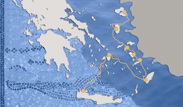The island
Naxos is the largest island in the Cyclades.
The expansive, rolling hinterland rises to a large mountain range bisecting the island. The
high peaks and steep slopes of the uplands, fertile plains and insular
landscape make for an environment of contrasts. Naxos
is ideally suited for crop and livestock farming, the islanders’ main
occupations, and is also rich in minerals and commercial shipping.
In the Early Bronze Age
(3200-2000 BC) Naxos was one of the prominent
commercial and cultural centres of Cycladic civilization. Archaeological
excavations have brought to light an extensive network of settlements and
cemeteries, revealing the density of habitation, while groups of Cycladic
figurines prove the existence of workshops around the island. Evidence of the
island’s organisation and prosperity lies in the wealth of information that can
be used to reconstruct the image of sites such as the citadel on Korfari
Amygdalies at Panormos, the settlement and cemeteries of Grotta at Aplomata and
Kamini, the cemetery of Agioi Anargyroi, and the late Neolithic
installation at Za cave.
Together with the large number of marble finds, the high quality of Naxos marble and emery leave no doubt as to the island’s commercial
and artistic significance in Cycladic Bronze Age culture.
Archaic period sanctuaries
and sculptures stand as indisputable evidence that Naxos
maintained its influential position in the Aegean
in historic times. In 490 BC the island was razed by the Persians before
aligning with Athens,
either as a member of the First and Second Athenian Alliance or as a vassal. In the
Hellenistic period Naxos was a member of the League of Islanders (2nd century
BC.) and in 41 BC was incorporated into the Roman Province of the Islands in
the Aegean (Provincia Insularum).
Information about the early
Christian period on the island is provided by ecclesiastical texts. Naxos belonged to the Diocese of Rhodes; its first
bishops were Auxentios and Barachos, who participated in the Ecumenical
Councils of Serdica (343) and Chalcedon
(451) respectively. There are a significant number of Byzantine churches on Naxos, the most typical form being the vaulted single-nave
oblong basilica
period on the island is provided by ecclesiastical texts. Naxos belonged to the Diocese of Rhodes; its first
bishops were Auxentios and Barachos, who participated in the Ecumenical
Councils of Serdica (343) and Chalcedon
(451) respectively. There are a significant number of Byzantine churches on Naxos, the most typical form being the vaulted single-nave
oblong basilica . Several of
these were built over ancient temples. Panagia Drosiani at Moni and Panagia
Protothroni at Halki stand out among early Christian churches, both of which retain the earliest layers of
decorative frescoes from the 6th and 7th centuries. One particularly
interesting feature of wall painting
. Several of
these were built over ancient temples. Panagia Drosiani at Moni and Panagia
Protothroni at Halki stand out among early Christian churches, both of which retain the earliest layers of
decorative frescoes from the 6th and 7th centuries. One particularly
interesting feature of wall painting on the island is the high concentration of
nonfigurative iconographic
on the island is the high concentration of
nonfigurative iconographic programs dating to the
Iconoclast controversy
programs dating to the
Iconoclast controversy (724-843). Directly linked to contemporary historical events,
they are to be found in the churches of Panagia Protothroni, Agios Artemios,
Agia Kyriaki, and Agios Ioannis (St. John) the Theologian.
(724-843). Directly linked to contemporary historical events,
they are to be found in the churches of Panagia Protothroni, Agios Artemios,
Agia Kyriaki, and Agios Ioannis (St. John) the Theologian.
In the 7th
century Naxos became the target of attacks by
Saracen pirates, not least on account of its key location on the trade route
connecting Constantinople to Alexandria. Arab interest in the island
remained strong over the next centuries, leading to repeated raids by the Arab Emirate
of Crete (824-961) in the 9th and 10th centuries. Furthermore, it seems that Naxos and other Aegean islands fell under Cretan Arab control
in the mid-10th century.
The island’s trading status
improved following the onset of the Crusades. Contemporary sources record stock
farming and trade in its commodities as the Naxiots’ principal occupation. A chrysobull issued by Emperor Alexius III Angelus in 1198 included Naxos
among the areas where the Venetians enjoyed tax exemptions and trade
concessions.
Throughout the Byzantine period the capital of the island was Apaliros Castle,
to the south of Sangri.
issued by Emperor Alexius III Angelus in 1198 included Naxos
among the areas where the Venetians enjoyed tax exemptions and trade
concessions.
Throughout the Byzantine period the capital of the island was Apaliros Castle,
to the south of Sangri.
After the fall of Constantinople to the Franks in 1204 and the treaty partitioning
the Byzantine Empire (Partitio Terrarum Imperii
Romaniae), Naxos initially became seat of the
so-called Territory of the Dodecanese. A few
years later, in 1207, Venetian nobleman Marco Sanudo and his men landed at Agiassos Bay and occupied the island. He
proceeded to take another eighteen islands and establish the Duchy of the Aegean, designating Naxos
as his headquarters. One of Sanudo’s first projects on the island was to build
a wall around Chora (Naxos town), on the site
of the ancient citadel, and then to transfer the capital there from Apaliros Castle. An attempt by Emperor Michael
VIII Palaeologus to retake the island in 1262 proved short-lived, as the next
Venetian duke, Guglielmo Sanudo, recaptured Naxos
and restored rule until about mid-16th century.
The period of Venetian domination ended in 1537, when Hayreddin
Barbarossa, commander of the Ottoman fleet, conquered Naxos
and made it tributary to the sultan.
Bibliography (3)▼
Comments (0)▼
New Comment▼














